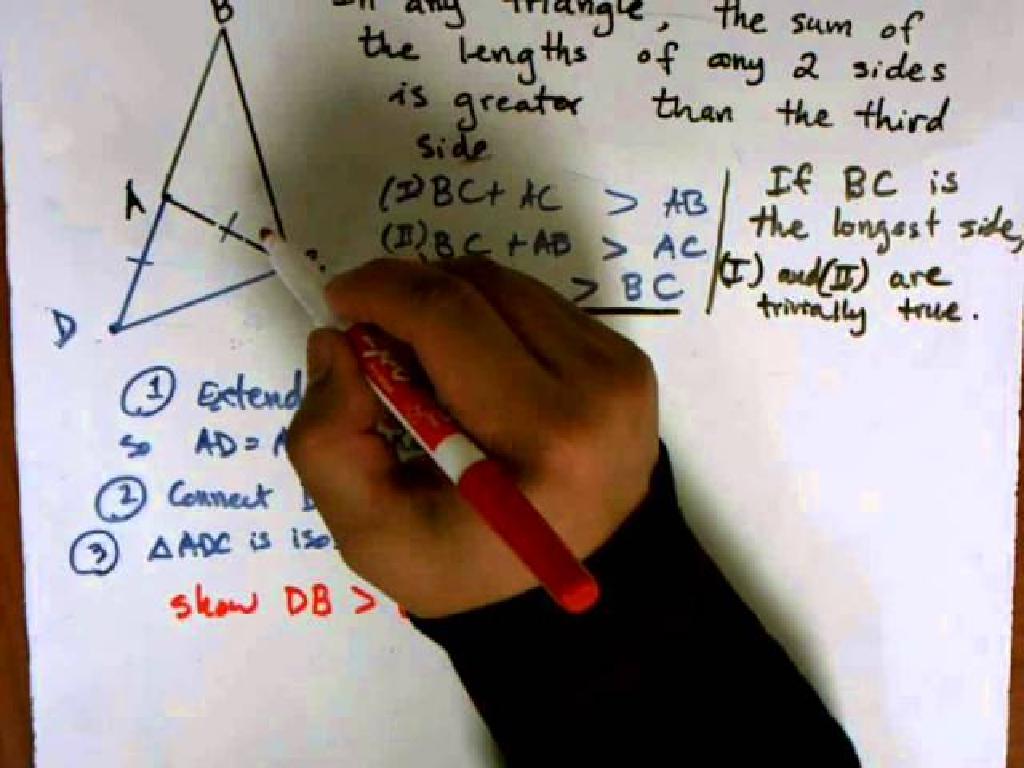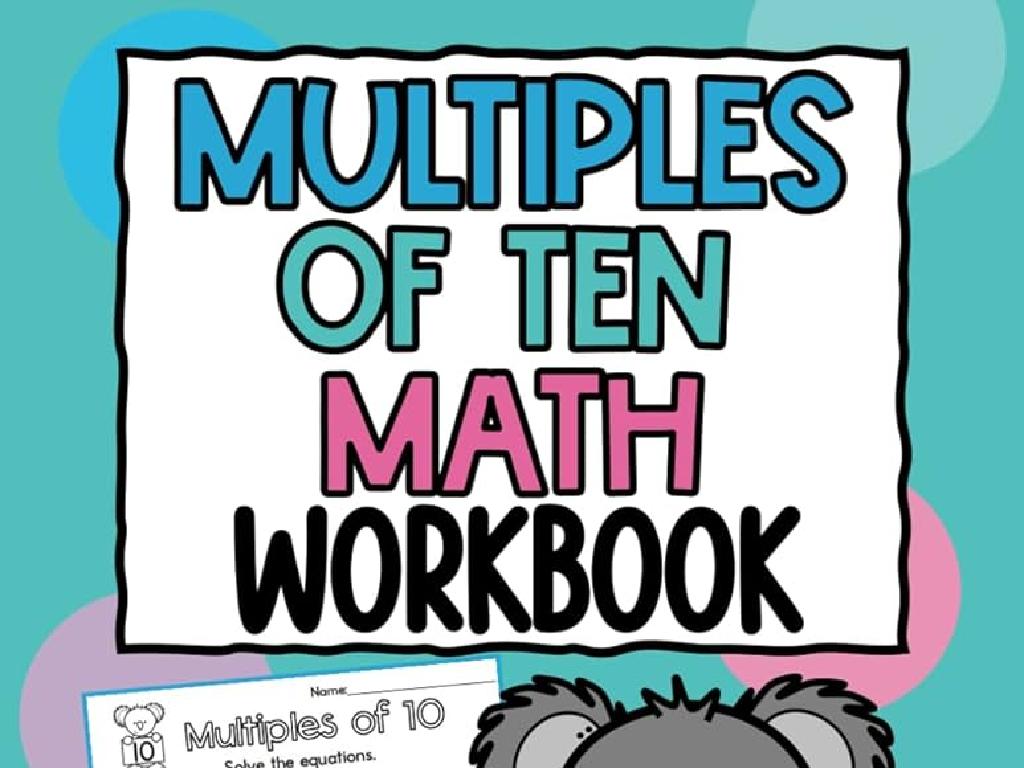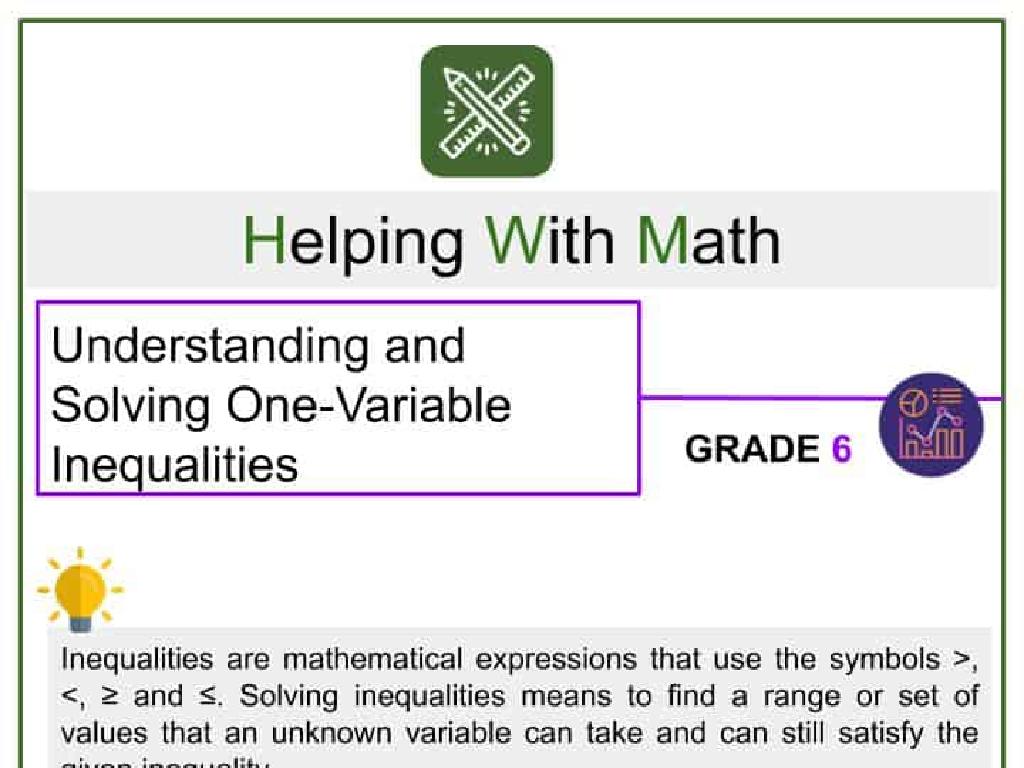Spell The Digraph Or Trigraph Word: Ph, Mb, Kn, Wh, Dge, Tch
Subject: Language arts
Grade: Third grade
Topic: Blends, Digraphs, And Trigraphs
Please LOG IN to download the presentation. Access is available to registered users only.
View More Content
Exploring Blends, Digraphs, and Trigraphs
– Special letter combinations intro
– Blends are two letters that make a single sound e.g., ‘bl’ in block
– Importance of blends, digraphs, trigraphs
– They help us decode words and improve spelling
– ‘ph’ sound in words
– ‘ph’ sounds like ‘f’, as in ‘phone’ or ‘dolphin’
– Class participation
|
This slide introduces students to the concept of blends, digraphs, and trigraphs, which are combinations of letters that produce unique sounds. Emphasize the importance of these in reading and spelling. For example, ‘ph’ makes an ‘f’ sound and is found in words like ‘phone’. Engage the class by asking them to think of words that contain the ‘ph’ sound. This interactive approach will help students apply their understanding of phonics to real-world reading and spelling tasks. Encourage students to listen carefully to words and identify the sounds made by different letter combinations.
Exploring Blends in Words
– Definition of blends
– Blends combine two+ consonants, each sound is heard.
– Examples of blends
– ‘bl’ in ‘black’, ‘st’ in ‘stop’.
– Listening to blend sounds
– Practice identifying blends
– We’ll listen and try to pick out the blend sounds.
|
This slide introduces the concept of blends in words, which is foundational for understanding digraphs and trigraphs. Blends are groups of two or more consonants where each consonant’s sound is still audible. Provide clear examples such as ‘bl’ in ‘black’ and ‘st’ in ‘stop’ to illustrate the concept. Engage the class by playing audio clips of words with blends and asking students to identify the sounds. Encourage participation and practice by having students come up with additional words that contain blends. This activity will help students recognize and pronounce blends, preparing them for more complex phonetic patterns like digraphs and trigraphs.
Exploring Digraphs in Words
– What are digraphs?
– Two letters making one sound, like ‘sh’ in ‘ship’.
– ‘ph’ sounds like ‘f’
– In ‘phone’, ‘ph’ is pronounced as ‘f’.
– Find more examples
– Let’s discover other words with ‘ph’.
– Group activity
|
This slide introduces the concept of digraphs to third-grade students. Begin by explaining that a digraph is a combination of two letters that produce a single sound. Use ‘phone’ as an example to illustrate the ‘ph’ digraph, which sounds like ‘f’. Encourage the class to actively participate by thinking of and sharing other words that contain the ‘ph’ digraph. This can be turned into a fun group activity where students work together to list words and share them with the class. The activity will help reinforce their understanding of digraphs and how they function in words.
Exploring Trigraphs in Words
– What are trigraphs?
– Three letters combining to make one sound.
– Example: ‘tch’ in ‘watch’
– ‘tch’ sounds like ‘ch’ in ‘chop’.
– Class activity: Spelling trigraphs
Let’s spell words with ‘tch’, like ‘catch’, ‘pitch’, ‘stitch’.
– Practice makes perfect!
|
This slide introduces the concept of trigraphs to third-grade students, focusing on how three letters can come together to create a single sound. Use ‘watch’ as a clear example to show the ‘tch’ trigraph. Organize a class activity where students spell out trigraph words together, reinforcing their understanding through practice. Encourage participation by asking students to come up with additional words that contain the ‘tch’ trigraph. Provide guidance and positive feedback as they explore and learn. The goal is to make them comfortable with identifying and using trigraphs in their spelling and reading.
Silent Letters in Digraphs and Trigraphs
– Digraphs/trigraphs have silent letters
– ‘k’ in ‘knock’ is silent
– Like ‘knee’, ‘knife’, where ‘k’ is not pronounced
– ‘w’ in ‘whale’ is silent
– Like ‘who’, ‘whistle’, where ‘w’ is not pronounced
– Practice finding silent letters
|
This slide introduces the concept of silent letters within digraphs and trigraphs to the students. Explain that not all letters in a word are always pronounced, and this is particularly common in certain letter combinations. Use examples like ‘knock’ and ‘whale’ to illustrate silent ‘k’ and ‘w’. During the class activity, have students practice identifying silent letters in words by providing them with a list of words containing digraphs and trigraphs. Encourage them to say the words out loud to determine which letter is silent. Activities can include word matching, fill-in-the-blanks, or a silent letter word hunt.
Spelling with Special Sounds
– ‘ph’ sounds like ‘f’
– Example: ‘phone’ not ‘fone’
– ‘mb’ has a silent ‘b’
– Example: ‘thumb’ not ‘thum’
– ‘kn’ starts with a silent ‘k’
– Example: ‘knight’ not ‘night’
– ‘wh’, ‘dge’, ‘tch’ tricks
– ‘wh’ as in ‘whale’, ‘dge’ as in ‘badge’, ‘tch’ as in ‘catch’
|
This slide introduces students to the concept of digraphs and trigraphs, which are combinations of letters that produce a single sound. The focus is on the sounds made by ‘ph’, ‘mb’, ‘kn’, ‘wh’, ‘dge’, and ‘tch’. Emphasize that ‘ph’ is pronounced as ‘f’ and that in ‘mb’ the ‘b’ is silent. Similarly, ‘kn’ begins with a silent ‘k’. Provide examples for each and practice spelling them on the board. For ‘wh’, ‘dge’, and ‘tch’, give words that illustrate their unique sounds. Encourage students to listen carefully to the pronunciation and practice with words that contain these sounds. During the next class, review these concepts and have students spell words using these digraphs and trigraphs to reinforce their learning.
Class Activity: Word Detective
– Become a word detective today
– Search for ‘ph’, ‘mb’, ‘kn’, ‘wh’, ‘dge’, ‘tch’
– Find words in books, posters, or labels around the class
– Write down your findings
– Keep a list of the words you discover
– We’ll spell them as a team
|
This activity is designed to engage students in identifying digraphs and trigraphs in a fun and interactive way. Encourage them to look for words in their environment – on book covers, instructional posters, or even classroom labels. As they find words containing the specified sounds, they should write them down. After the search, gather the students and spell the words together, reinforcing their phonetic skills. Possible variations of the activity could include working in pairs, using a timer to create a sense of urgency, or assigning specific sounds to different groups to ensure a wide range of examples.
Let’s Play a Spelling Game!
– Listen to the word I say
– Write it on your whiteboard
– Think about special letter blends
– ph, mb, kn, wh, dge, tch are some blends we learned
– Show your spelling skills!
|
This slide introduces a spelling game designed to reinforce the lesson on digraphs and trigraphs. The activity involves the teacher saying words aloud that contain the special letter combinations (ph, mb, kn, wh, dge, tch) and students writing them on their whiteboards. The game aims to help students apply their knowledge of these blends in a fun and interactive way. For the teacher: Prepare a list of words that include the taught letter combinations. Say each word clearly and give students time to write it down. After revealing the correct spelling, discuss any common mistakes. Encourage students to explain the clues that helped them determine the correct spelling. This activity not only reinforces the day’s lesson but also promotes active learning and student engagement.
Conclusion and Review: Celebrating Our Learning
– Applauding our hard work today
– Share a new word you’ve learned
– Did you learn ‘phone’ or ‘knight’?
– Practice is key to spelling success
– Keep exploring digraphs and trigraphs
– Look for ‘wh’, ‘dge’, ‘tch’ in your favorite books!
|
As we wrap up today’s lesson on digraphs and trigraphs, take a moment to celebrate the students’ effort and progress. Encourage them to share a new word they’ve learned to reinforce their understanding and to give them an opportunity to teach their peers. Emphasize the importance of regular practice in mastering spelling, especially with complex letter combinations like ‘ph’, ‘mb’, ‘kn’, ‘wh’, ‘dge’, and ‘tch’. Suggest that they continue to look for these patterns in their reading outside of class to strengthen their recognition and recall of these tricky spellings.
Homework Challenge: Special Sounds Hunt
– Find words with special sounds
– Look for ph, mb, kn, wh, dge, tch
– Choose five words from a book
– Pick your favorite book for this adventure
– Draw pictures for each word
– Illustrate what each word represents
– Get ready to present them
– Share your words and art next class
|
This homework task is designed to reinforce the students’ understanding of digraphs and trigraphs by identifying them in the context of reading. Encourage students to look for words containing the specific sounds ‘ph’, ‘mb’, ‘kn’, ‘wh’, ‘dge’, and ‘tch’ in books they enjoy. This activity will help them recognize these sounds in different words and understand their meanings. By drawing related pictures, students will connect the sounds to visual representations, enhancing their memory and comprehension. Prepare for a show-and-tell session in the next class where students can proudly display their findings and artwork, fostering a fun learning environment and peer learning.






